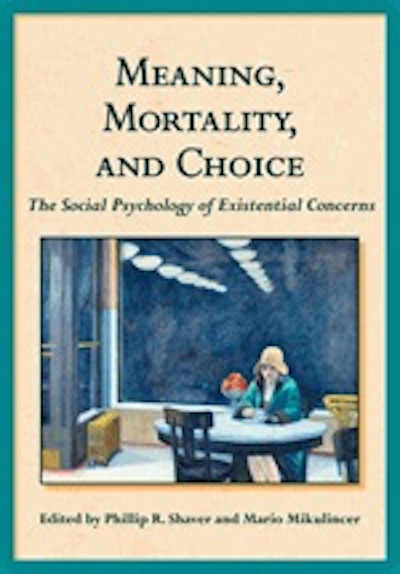
Edited by Phillip R. Shaver and Mario Mikulincer
Washington, DC: American Psychological Association, 2012. 438 pp.
ISBN 978-1-4338-1155-5 $49.95
Reviewed by Paul T. P. Wong
Overall Impression of the Book
This edited volume is primarily concerned with how our existential concerns affect our goals, attitudes, and behavior. More specifically, it focuses on the four existential anxieties identified by Yalom (1980): death, meaninglessness, freedom, and alienation. The editors are correct in pointing out that these concerns weigh heavily on contemporary human beings, but they are incorrect in assuming that these concerns “caus[e] some to despair and a considerable number to use drugs, illegal or legally prescribed, to blunt the misery. A few even decide to end their lives” (xv).
My immediate reaction is that such concerns may also have positive effects such as living more meaningfully and responsibly in order to make the best use of our limited time on earth.
Elsewhere, I pointed out that every existential anxiety reflects a fundamental human need, a positive existential given (Wong, 2005a). Alienation anxiety is simply the other side of the coin of the need for relationship and attachment, freedom anxiety reflects the need for autonomy and freedom, while the anxiety of meaninglessness reflects the need for meaningfulness. Finally, death anxiety reflects the human desire for personal growth and authenticity.
For the existentialists, such as Yalom (2008), the most effective ways of coping with death anxiety are living authentically and being engaged in relationships. Meaning, Mortality, and Choice would be more useful for both social psychologists and existential psychologists, if it paid more attention to positive existential givens and recognized that the people are capable of conscious and purposeful actions.
In fact, Ryan and colleagues (Chapter 12) raised the same criticism and advocated for a positive message of existentialism. They pointed out that people are not “fearful, weak, defensive, and nonconsciously driven animals” (p. 216) as portrayed by TMT; people are free, autonomous, responsible, growth-oriented, and consciously act in accordance with their values, according to self-determination theory (SDT).
Death Anxiety vs. Death Acceptance
Section One is all about Terror management theory (TMT), which represents the most successful and influential social psychological theory that addresses death anxiety. However, the domination of this theory may have hindered the development of other approaches of integrating social/personality psychology with existential-humanistic concerns. Since death is the final event of every human life, it overshadows most, if not all, our goals, attitudes and behaviors. We can always interpret this effect in terms of TMT’s defense mechanisms, but in so doing, we may overlook some more parsimonious interpretations, such as those put forth by meaning management theory (Wong, 2005b; Wong & Tomer, 2011).
In chapter 3, Arndt is correct in observing that “all people are on a parallel quest, trying to endure the all too-often hardship of life and their awareness of inevitable death to feel that they count, they matter. There is comfort in being in the same, albeit inevitably sinking, ship. Perhaps, then I should have asked my brother: In what way would you like to be special?” (p. 68).
I would bet anything that if you pose this question to different people, you will find a variety of answers related to different pathways to achieving personal significance and overcoming adversities; some of the pathways may not have anything to do with identification with one’s cultural worldview or the pursuit of self-esteem. People who aspire to be like Martin Luther King or Mahatma Gandhi are more concerned about completing their mission for the common good than protecting themselves against the threat of death. They simply accepted death as a price they may pay for their pursuit of a noble purpose.
There is now a growing literature on death acceptance (Tomer, Eliason, & Wong, 2008), as well as acceptance as a general coping strategy. Those in the TMT camp need to at least reconcile death acceptance with death anxiety; the former may alleviate or wipe out the effects of mortality salience.
What Makes Life Meaningful
Section II, The Threat of Meaninglessness, comes closer to recognizing the human need for meaning as a positive existential given. One of the main themes of positive psychology is what makes life worth living, which is consistent with Frankl’s emphasis on the positive potentials of meaning fulfillment. I am puzzled that there is only a single passing reference to Viktor Frankl’s (1985) Man’s Search for Meaning, without any consideration of the vast impact Frankl has had on social-personality psychology (e.g., Wong, 2009; Wong, 2012).
Laura King (Chapter 7) does not address the central issue of what makes life worth living. She is primarily interested in the intuitive information-processing involved in the sensing of meaning rather than existential meaning. To claim that meaning is a ubiquitous aspect of human experience is to state that human beings, in their waking hours, are consistently sensing or making meaning for the pragmatic purpose of understanding and predicting the world in which they live. She reports numerous clever experiments on positive affect and sensing of meaning. The take home message is that “judgments of meaning in life are strongly influenced by intuitive factors, such as positive affect” (p. 141). However, the problem of a deeply felt sense of emptiness is unlikely to be solved by the presence of positive emotion or intuitive meaning. When there is a lack of significance, purpose, and content in one’s life, how would intuition fill the void?
Park and Edmondson (Chapter 8) focused on religion as a main source of global meaning and the role of meaning-making in traumatic and ordinary circumstances. These authors certainly recognized “the universal human need for meaning is a widely accepted notion. The need is generally described as a drive to understand one’s experience and to feel that one’s life has significance and purpose.” (p.145). They proposed that focusing on the functional meaning system for various meaning-related needs, such as significance, control, and agency, may be more promising that focusing on death anxiety.
Freedom and Autonomy
Chapter 12 (Ryan et al.) stands out because it stems from a humanistic vision of human nature as motivated towards autonomy and personal growth, in contrast to TMT’s vision of human beings as primarily motivated by unconscious defense mechanisms against death threats. This chapter demonstrates how rigorous scientific research and theorizing about existential concerns can help people live better lives and plan a better future.
Schwartz (Chapter 15) documented that too much freedom might not be a good thing and that certain obligations and constraints may be beneficial in providing structure and meaning to people’s lives. “Choice is what enables people to tell the world who they are and what they care about” (p. 272), but it is also important to understand one’s place in a social group. Thus, a good life requires a balance between individual freedom and communitarian values. This chapter demonstrates the value of integrating existential literature with social psychology, and linking experimental studies to practical implications.
Ironically, none of the chanters in this section directly address the existential anxiety related to freedom. Freedom evokes anxiety simply because selecting A automatically negates option B and C, etc. and life is too brief to make wrong choices. Schwartz (chapter 15) indirectly links this anxiety to the number of options.
Other People Matter
In the existential literature, there are two kinds of alienation – social isolation and existential or ontological alienation (Yalom, 1980). In some sense, we are all vaguely aware that we both enter and depart from the world alone. In chapter 16, Shaver and Mikulincer provided evidence to support the adult attachment theory. They showed that a heightened sense of existential concerns, whether about mortality, meaninglessness, isolation, or a lack of freedom) would activate the attachment system, as manifested in moving towards others or mental representations of them. They also concluded that those who “are treated well by others, beginning early in life, find life engaging, enjoyable and meaningful” (p.303). This is an exciting area of research, because other people matter both for our well-being and protection against existential concerns without resorting to the defense mechanisms of TMT.
Solomon (Chapter 22) wrote: “Humans are fundamentally social symbolizing creatures who want to feel they are persons of worth in a cultural world of meaning.” This, to me, is probably the most memorable quotation, because it emphasizes relationships and meaning making as the most important human capacities to become fully functioning in spite of awareness of death.
Conclusions
I applaud the vision of the Interdisciplinary Center Herzliya to fund a symposium exploring social-personality research on existential issues. I believe that the future of social-personality psychology depends on such integration, because most of the existential concerns of ordinary folks have not received sufficient attention from psychology researchers and there is a wealth of profound insights from existential-humanistic psychologists that wait for scientific investigation.
The editors have referred to such integration as “existentialist science” (p. 14) or “experimental existential psychology” (p. 17), but neither of such labels is an adequate description of this emerging area. To gain a deeper understanding of human beings, we cannot simply depend on clever manipulations or quick-and-dirty rating scores. I can readily visualize some form of holistic research methodology in investigating existential givens in a way that is more consistent with the phenomenological emphasis of existential psychology. A holistic methodology is not only inevitable but also desirable, if we are serious about bridging these two traditions.
Overall, the editors have done a competent job in producing a volume with many provocative chapters and diverse views. I recommend this edited volume as a useful resource for anyone interested in linking social-personal psychology to existential psychology. Although it has three well written chapters devoted to applications, the book as a whole would not appeal to clinicians.
References
- Frankl, V. (1985). Man’s search for meaning. Boston, MA: Beacon Press.
- Tomer, A., Eliason, G. T., & Wong, P. T. P. (Eds.). (2008). Existential and spiritual issues in death attitudes. Mahwah, NJ: Lawrence Erlbaum Associates.
- Wong, P. T. P. (2005a). Existential and humanistic theories. In J. C. Thomas, & D. L. Segal (Eds.), Comprehensive Handbook of Personality and Psychopathology (pp. 192-211). Hoboken, NJ: John Wiley & Sons, Inc
- Wong, P. T. P. (2005b). The challenges of experimental existential psychology: Terror management or meaning management? [Review of the book Handbook of experimental existential psychology]. PsycCRITIQUES, 50.
- Wong, P. T. P. (2009). Viktor Frankl: Prophet of hope for the 21st century. In A. Batthyany & J. Levinson (Eds.), Existential psychotherapy of meaning: Handbook of logotherapy and existential analysis. Phoenix, AZ: Zeig, Tucker & Theisen, Inc.
- Wong, P. T. P. (Ed.). (2012). The human quest for meaning: Theories, research, and applications (2nd Edition). New York, NY: Routledge.
- Wong, P. T. P., & Tomer, A. (Guest Eds.). (2011). A special issue on death acceptance in Death Studies, 35(2), 99-106. (Need title for the article)
- Yalom, I. D. (1980). Existential psychotherapy. New York: Basic Books.
- Yalom, I. D. (2008). Staring at the sun: Overcoming the terror of death. San Francisco, CA: Jossey-Bass.
Cite
Wong, P. T. P. (2013). Linking social psychology to existential psychology: Promises and challenges. PsycCRITIQUES, Vol 58(4). doi: 10.1037/a0031077
